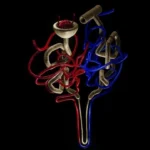Our sun is too small to be a black hole.
When the hydrogen fuel is depleted, our Sun will begin to burn helium, swell and rapidly become a red giant, perhaps it will touch the orbit of Venus.
However, once the helium fuel is exhausted, the Sun will shrink into a white dwarf, still bright due to the enormous amount of heat trapped inside, but will not burn any more fuel.
Then begins a protracted cooling process, which represents the final stage of a star like our Sun.
Massive stars may have enough mass to create the pressure and temperature needed in their cores to incorporate heavier elements such as oxygen and carbon.
But our Sun is too small for that, so such a merger will not take place.
The end of the lives of these very massive stars can be very violent.
When they run out of fuel, they reach a point where their cores rapidly collapse, releasing a huge amount of energy left behind by the remaining stars.
This is called a core-collapse supernova.
The remnants can become a dwarf star; Or if it is massive enough (currently at least 50% heavier than our Sun), it could collapse deeper into a neutron star.
Ultimately, if the remnant is at least three times more massive than our Sun, the collapse won’t stop there either but will continue and turn into a black hole.
But not on our Sun. As I said, our Sun is too small for these dramatic events.
In Nut-Shell
As stated earlier, hydrogen dissolves into helium which settles in the center of the core.
Now helium fuses into carbon, carbon is deposited in the core again, and carbon needs a temperature of 600 million degrees Kelvin to initiate fusion.
A star about the same mass as the Sun would not have enough carbon at its core.
You have to compress enough carbon atoms to make 600 million degrees Kelvin.
Less massive stars simply don’t have enough mass and it all starts with the amount of hydrogen when stars are born.
Why Do Massive Stars Become Black Holes Instead of Neutron Stars
Massive stars have enough hydrogen to begin with, and these massive stars will initially go through the same fusion cycle as the Sun.
Hydrogen to helium and helium to carbon, but now there is enough matter for the star to continue the fusion cycle of hydrogen-helium-carbon-neon-oxygen-magnesium-silicon and sulfur and eventually iron.
All of the above fusion cycles generate energy (pressure) and will maintain some degree of hydro static equilibrium, albeit to an increasing degree of instability.
But once the star runs out of silicon, it can no longer combine with iron.
Do this because the star needs energy and cannot borrow it from friends.
For a split second, the star found itself trapped under the immense gravity.
This will happen at about 15% of the speed of light.
The energy produced by this explosion is so intense that the star has never experienced it before.
This energy explodes outward and collides with an explosion of incoming matter at 15% the speed of light, creating a supernova.
The remnants of this supernova will become either a neutron star or a black hole.
Things that will change
Of course, without sunlight, life on Earth would be in great difficulty.
The earth would begin to cool and the carbon cycle would be disrupted without photosynthesis, which would break down CO to produce O2.
Plants will begin to die due to lack of photosynthesis and animals will begin to die as the number of plants decreases and the concentration of O2 in the atmosphere gradually decreases.
We will all eventually die of the cold.
I’m not sure about the timing of these various issues, so I can’t say which will hit us first, but the outcome is certain.
We will all die.
Its movement will be relatively peaceful (though it will continue to burn, possibly even being destroyed when the Earth dies).
👇👇👇
What are the possibilities of life on Mars | Is Mars habitable for human life






